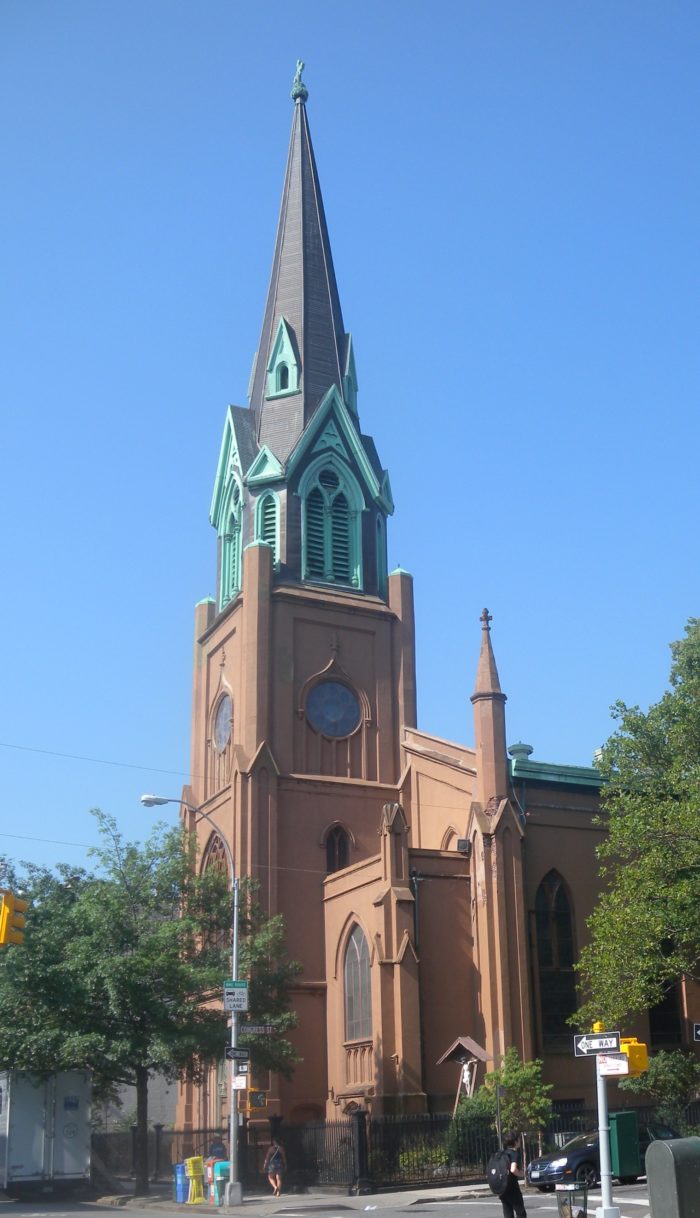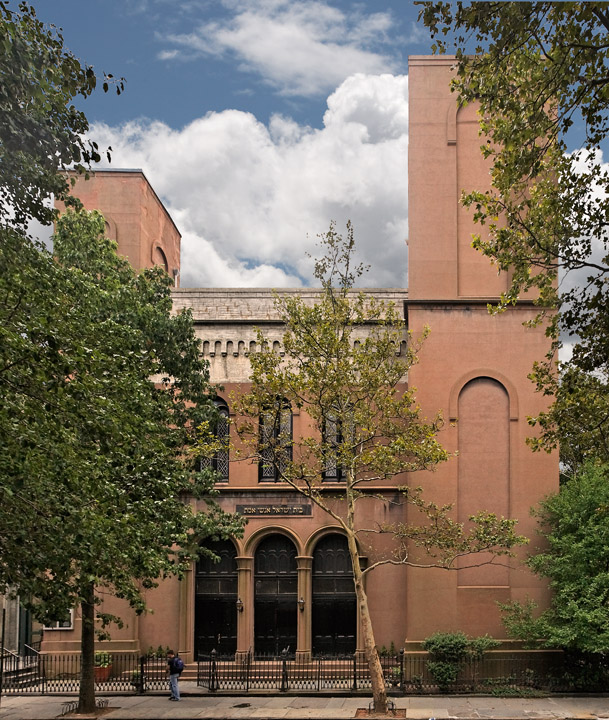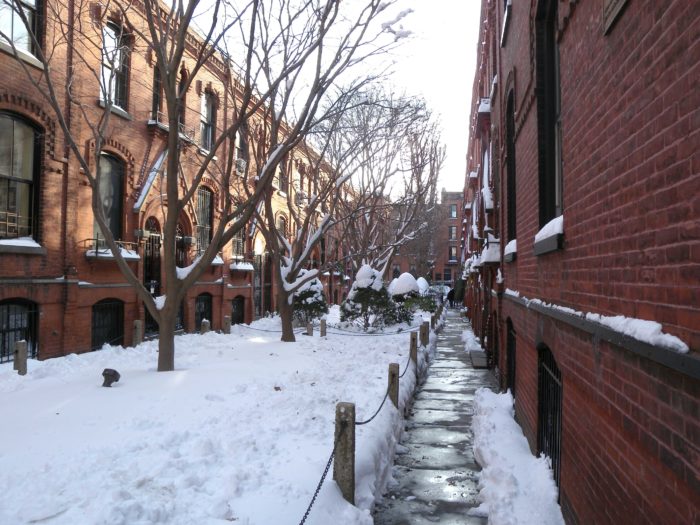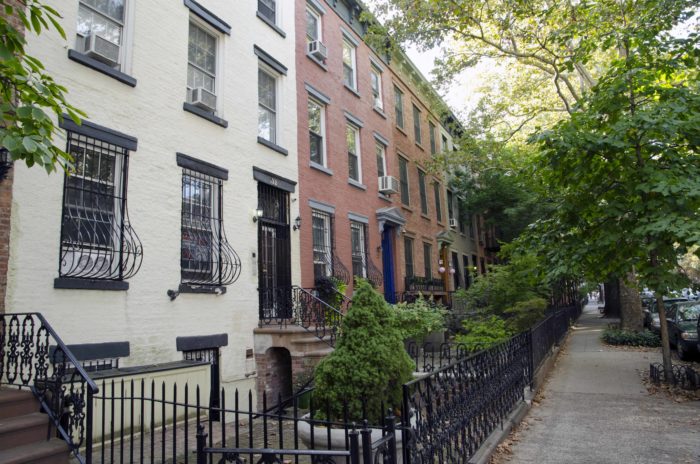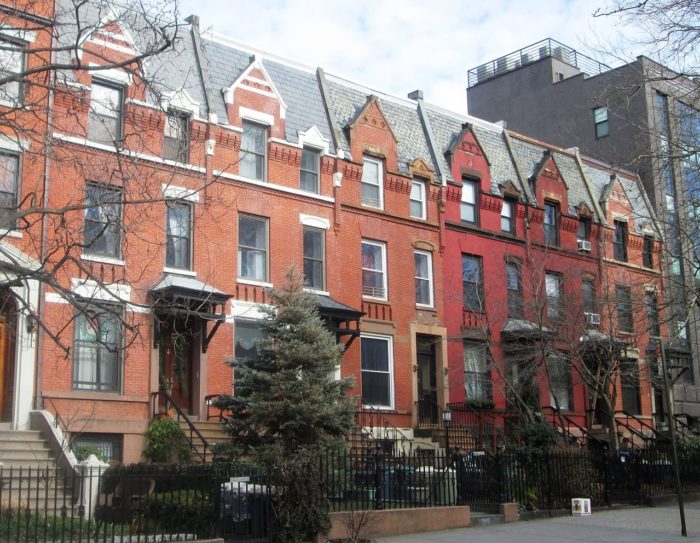Finding historic landmarks in Cobble Hill, Boerum Hill, and Carroll Gardens is easy. Not only does each neighborhood have its own historic district, but the Cobble Hill Historic District encompasses the vast majority of that neighborhood. If it is picturesque, Instagram-ready buildings you want, this is the area of Brooklyn for you.
The blocks alongside the Brooklyn-Queens Expressway between Atlantic Avenue and Congress Street are the only parts of Cobble Hill outside the historic district. The city granted the rest of the neighborhood its historic designation in 1969 largely for its wealth of 19th-century buildings in a variety of styles. On Congress Street alone you’ll find a mid-19th-century Gothic Revival house that has since been converted to apartments, Civil War-era Italianate-style row homes, Queen Anne-influenced brownstones dating to the 1880s, a Neo-Greco townhome, and a former stable in addition to St. Paul’s Roman Catholic Church.
Old St. Paul’s Church. Image: Jim.henderson/Wikimedia
Built in 1838 at the corner of Congress and Court Streets, St. Paul’s—aka Old St. Paul’s Church—was the second Roman Catholic church built in Brooklyn and is the borough’s oldest Catholic church in continuous use. If that alone is not enough to encourage a visit, the building’s Gothic Revival flair makes it worth a stop on any walking tour of the neighborhood.
Kane Street Synagogue. Image: Hank Gans/Wikimedia
Another notable religious institute in Cobble Hill is the Kane Street Synagogue, at the corner of Kane and Tompkins Place, home to Brooklyn’s oldest continuously operating Jewish congregation. Built in 1855 as the Middle Dutch Reformed Church, the Romanesque Revival building also served as a Lutheran church before being bought by Congregation Baith Israel Anshel Emes in 1905.
Warren Place is even more delightful when not covered in snow. Image: Jim.henderson/Wikimedia
No stroll through Cobble Hill would be complete without a visit to Warren Place. In 1876, philanthropist and housing advocate Alfred Tredway White bought and built a block running from Warren and Baltic Streets between Henry and Hicks Streets. Flanking a slender, beautifully tended English-style courtyard complete with fountain, 34 Gothic-style row houses were constructed expressly for low-paid workers. Also called the Workingsman’s Cottages, these cozy homes—each is about 11.5 feet wide and 1,000 square feet—originally rented for about $18 a month. Those first inhabitants would doubtless be stunned to see how in-demand their once-humble abodes are now.
Boerum Hill Historic District. Image: Edwardhblake/Wikimedia
Encompassing roughly five blocks, the Boerum Hill Historical District is appreciably smaller than that of Cobble Hill. It runs from Pacific Street to Dean Street between Nevis and Bond Streets, and from Dean Street to Wyckoff Street between Bond and Hoyt Streets, with some overflow north and west. When designating the area a historic district in 1973, the Landmarks Preservation Commission called out, as was the case in Cobble Hill, its architectural diversity, with homes in styles ranging from Gothic Revival to Greek Revival, with plenty of Italianate in between.
Nearly all 250 of the structures within the district are residential, though the building on the southwest corner of Bergen and Hoyt Streets originally housed a tavern. The elaborate metalwork ornamentation gracing its façade and three-sided upper-story windows make this building a standout. Another standout is 360 Pacific Street, between Bond and Hoyt Streets, which is the only wood-frame structure in the district. With a front porch and portico held up by columns, it almost appears to have been dropped by accident among the taller, more stately Italianate brownstones and brick homes.
Carroll Gardens Historic District. Image:Beyond My Ken/Wikimedia
Even more diminutive than the Boerum Hill Historic District is that of Carroll Gardens. It runs from President Street to First Place, and from Smith Street to a bit beyond Hoyt Street. The brownstones flanking these streets are the homes most people associate with the neighborhood. When planning the area in the 1840s, Brooklyn surveyor Richard Butts designed the houses to have 33-foot front yards. These set the houses farther back from the street and ensured that the area was more verdant than the surrounding neighborhoods. Especially in spring and summer, a walk through these blocks is a perfect antidote to a day spent among the concrete canyons of Manhattan.



